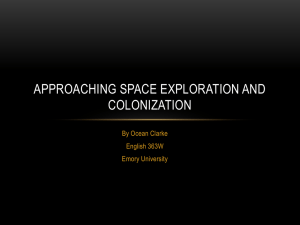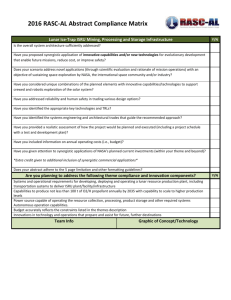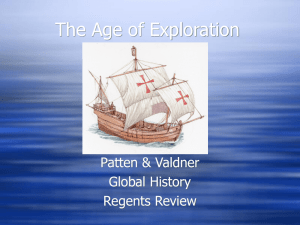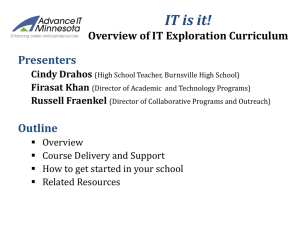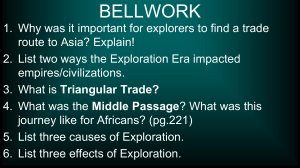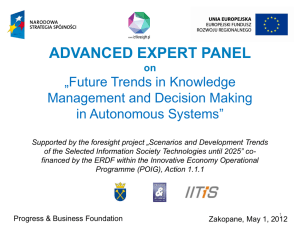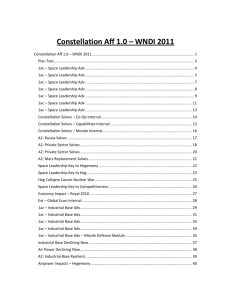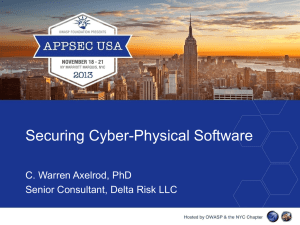Belvin_NIA_AIAA_July_24_2014 - National Institute of Aerospace
advertisement
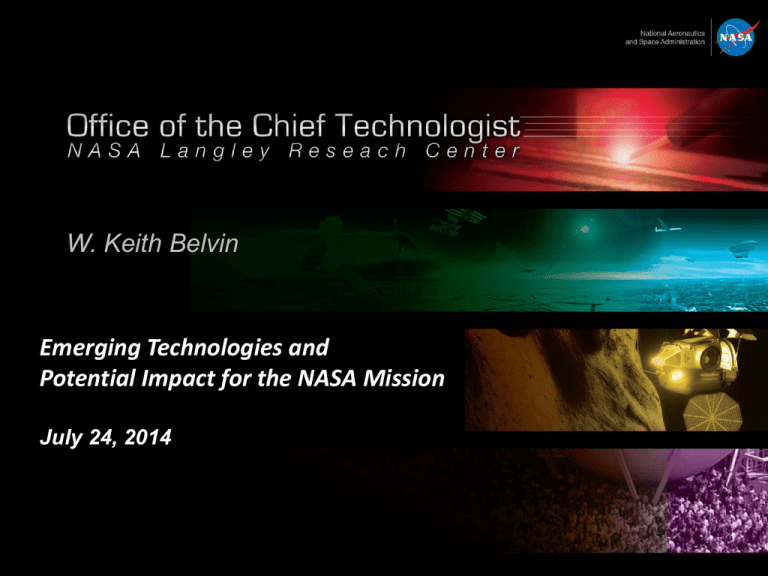
W. Keith Belvin Emerging Technologies and Potential Impact for the NASA Mission July 24, 2014 Four NASA Mission Areas Aeronautics Research Enable a safer, more secure, efficient, and environmentally friendly air transportation system. Human Exploration and Operations Operate the International Space Station and prepare for human exploration beyond low Earth orbit. Science Exploring the Earth-Sun system, our own solar system, and the universe beyond. Space Technology Develop the crosscutting, advanced and pioneering new technologies needed for current and future missions, benefiting the aerospace industry and other agencies, and 2 addressing national needs. NASA Technology Area (TA) Roadmaps TA01 Launch Propulsion Systems TA02 In-Space Propulsion Technologies TA03 Space Power and Energy Storage TA04 Robotics, Tele-Robotics and Autonomous Systems TA05 Communication and Navigation TA06 Human Health, Life Support and Habitation Systems TA07 Human Exploration Destination Systems TA08 Science Instruments, Observatories and Sensor Systems TA09 Entry, Descent and Landing Systems TA10 TA11 Nanotechnology Modeling, Simulation, Information Technology and Processing TA12 Materials, Structures, Mechanical Systems and Manufacturing TA13 Ground and Launch Systems Processing TA14 Thermal Management Systems TA15 Aeronautics 3 3 Some Important Tech Trends Cognitive Computing Big Data Analytics Autonomous Systems Internet of Things Aero Systems Military / Civil UAVs Personal Air Vehicles Satellites Sensors of ideas /solutions of funding of knowledge of air and space vehicles Robotic Space Human Space Exploration / Science Exploration 4 Elinor Otto Conference Topics • Socially intelligent robots • Robot companions • Lifelike robots • Assistive (health & personal care) robotics • Remote robots • Mixed initiative interaction • Multi-modal interaction • Long term interaction with robots • Awareness and monitoring of humans • Task allocation and coordination • Autonomy and trust • Robot-team learning 5 trends in … Robotics and Manufacturing industrial revolution (early 19th century) -70 percent of American workers lived on the farm - automation eliminated all but 1 percent of their jobs automation also created hundreds of millions of jobs in entirely new fields. • 3D printing • easy-to-use robots Third Industrial Revolution • collaborative manufacturing services The wheel is almost coming full circle, turning away from mass manufacturing and towards much more individualized production. Yes, Robots Are Coming for Our Jobs—Now What?: Scientific American http://www.scientificamerican.com/article.cfm?id=yes-robots-are-coming-for-our-jobs-nowwhat&WT.mc_id=SA_CAT_SP_20130311 . 6 Autonomy - Can we trust it? Autonomous Systems: Opportunities and Challenges for the UK Medical and Surgery Google Driverless Car Licensed in: Nevada – 2011 Florida - 2012 California - 2012 … 7 Control of Complex Systems 8 9 10 11 Small Satellites Proliferate! 12 Small Satellite Systems LOGAN, Utah —. From super-secret agencies and the U.S. military to academia and private firms, as well as world space agencies and NASA, ultra-small satellites are the big thing - be they minisatellites, microsatellites, nanosatellites, picosatellites, even the diminutive Femto satellite, weighing in at less than 100 grams. Stamp-size satellites, developed at Cornell University, are getting a test run aboard the International Space Station. 13 Small Aero Systems The Transition® Production Prototype completed its first flight on March 23, 2012 14 Smart Dust – Ubiquitous Sensing Smartdust is a system of many tiny microelectromechanical systems (MEMS) that can detect: • Light • Temperature • Vibration • Magnetism • Chemicals • … Enabled by wireless computer networking, radio-frequency identification (RFID) and various forms of energy harvesting Hitachi Creates RFID Powder DARPA “Smart Dust” project - to build a self-contained, millimeter-scale sensing and communication platform.." 15 trends in … the “Crowd” Crowd Sourcing Prizes and Challenges Yield High Return • Autonomous Vehicles • Space Suits • Lunar Landers • Commercial Space • … Crowd Funding the collective effort of individuals who network and pool their money, to support efforts initiated by other people or organizations… Social Networks, Professional Networks, Virtual Meetings, … People Want To Contribute to a Larger Cause 16 trends in … Knowledge • • • • Big Data Machine Intelligence/ Analytics Modeling and Simulation Human Augmentation … And the Democratization of Knowledge • Library of Utopia • Distance Learning • R&T moving East and South… Technology is increasingly a networked and international enterprise. Leadership in key fields will increasingly entail working But, the big change are global networks that tie people (innovators) together for ideation (new solutions) not just knowledge. with international partners. 17 Emergence of a Fourth Research Paradigm Data Intensive Science and Discovery 1.Thousand years ago – Experimental Science Description of natural phenomena; Galileo Lots of Climate Research Data – opportunity for Discoveries 2. Last few hundred years – Theoretical Science Newton’s Laws, Maxwell’s Equations 3. Last few decades – Computational Science Simulation of complex phenomena 4. Today – Data Intensive Science and Discovery Data from Instruments, simulations, sensors and satellites Escience is the set of tools and technologies For data mining, analysis and visualization For collaboration and dissemination For Ideation 18 A Digital Transformation is At Hand Digital Work Environment Simulation-Based Engineering & Science Capability Pillars Automated And Augmented Business Systems Synchronous Collaboration, Telepresence, Telework Pervasive Information; Discovery & Access to Global Knowledge Deep Analytics & Big Data Cyber-Physical Systems Machine Intelligence Lab-toComputer Instrumentation Modeling & Simulation Advanced Visualization Infrastructure – Seamless access, regardless of on/off-site, in-house, or external sourcing Mobile Devices Desktops, Laptops Communications: Phones (++) Office Apps, Databases, Scientific Apps, Business Apps, Web Framework, Knowledge Tools, Standards…. Servers High Performance Computing (HPC) Storage Systems, Backup, Archive Core Infrastructure: Networks, IT Security, Power, Physical Security On-Demand Trends • Amazon same day delivery … • Google launches same day delivery • Walmart mulls crowdsourcing for same-day shipping service 20 On –Demand Mobility • Aeronautics: Point-to-Point Civil Aviation - on-demand air mobility, utilizing unmanned and personal aerial vehicles, to allow people and goods to travel wherever, whenever, enabled by a high degree of automation and autonomy. 21 Earth Science – New Approaches to Climate? Active Remote Sensing • • • Lidar Inter-Satellite Calibration Large Instruments New Models for Earth’s Atmospheric Science • • Swarms of Small Sats – Increased temporal and spatial coverage (need to solve the calibration problem In-Situ Smart Dust – self configuring networks of ubiquitous sensors 22 Thriving on Earth: Earth Vital Statistics Healthy Planet Index Create multi-scale Sensor-Webs across the Earth to provide continuous monitoring of the health of our planet by the early 2020s. 23 Cyber Physical Tipping Point Cognitive Computing Big Data Analytics Autonomous Systems Internet of Things Military / Civil UAVs Personal Air Vehicles Satellites Sensors of ideas /solutions of funding of knowledge of air and space vehicles Cyber Physical Systems 24 Cyber-Physical Systems: The next revolution Cyber-physical systems (CPS) are physical and engineered systems Verification of cyber-physical systems still pose technical challenges IBM predicts 5 senses computing experiences within 5 years Just as the internet transformed how computers and humans interact with one another, cyberphysical systems will transform how we interact with the physical world around us. 25 A Revolution in Information and Knowledge Technology for the Crowd (Space Exploration for Everyone) Virtual Exploration Virtual Planetary Explorers Five Senses Data Fusion Citizen Scientists Cloud: Computing/D ata Big Data Analytics Participatory Exploration Asteroid Challenge Lunar Crater Challenge Crowd Sourcing "I want us to build a future of shared immersive tele-exploration.” http://www.theverge.com/2013/3/27/4154900/nasa-athlete-leap-motion-GDC 26 What is Technology? Technology Definition: A solution that arises from applying the disciplines of engineering science to synthesize a device, process, or subsystem to enable a specific capability. Government-Wide OMB Circular No. A-11 Conduct of R&D** A study directed toward fuller knowledge or understanding of the fundamental aspects of phenomena and of observable facts without specific applications toward processes or products. 6.2 Applied Research: Systematic study to gain knowledge or understanding necessary to determine the means by which a recognized and specific need may be met. 6.1 Basic Research: 6.3 Development: Is directed toward the production of useful materials, devices, and systems or methods, including design, development, and improvement of prototypes and new processes to meet specific requirements. 27 Summary • NASA missions have always been technology enabled. Emerging technologies in the areas of small, smart, and cyber physical systems will: • Enable on-demand mobility • Provide ubiquitous sensing and big data synthesis for science and discovery • Accelerate the emergence of citizen explorers and scientists • The third industrial revolution – robotic additive manufacturing - is critical to sustaining long duration space missions and permanent settlements. • The fourth research paradigm – data intensive science and discovery – has huge potential implications for how work is done (work environment) and on simulation based innovation (at the systems level). • Engineering Sciences – the precursor to technology- offer revolutionary changes to both what future missions NASA will pursue and how NASA will accomplish them. • • • • • Computationally Designed Materials Non-Chemical Energetics, e.g. LENR Synthetic Biology Machine Intelligence, e.g. Autonomy of CPS Human Augmentation MIT OPENCOURSEWARE BRAIN Initiative: Goals Brain Research through Advancing Innovative Neurotechnologies Accelerate development, application of innovative technologies to construct dynamic picture of brain function that integrates neuronal and circuit activity over time and space Build on growing scientific foundation – neuroscience, genetics, physics, engineering, informatics, nanoscience, chemistry, mathematics, etc. – to catalyze interdisciplinary effort of unprecedented scope 29 IBM Research IBM Research http://www.youtube.com/watch?v=Y_cqBP08yuA “ . . . the idea of the future being different from the present is so repugnant to our conventional modes of thought and behavior that we, most of us, offer a great resistance to acting on it in practice.” John Maynard Keynes, 1937 33
